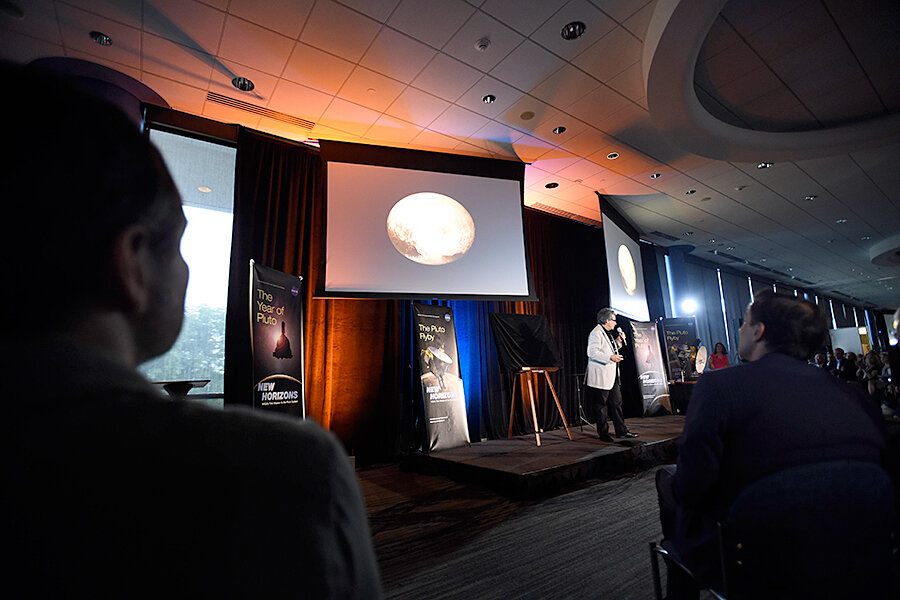Pluto flyby: New Horizons phones home, confirms more data is coming
Loading...
| Laurel, Md.
After nearly 22 hours of uneasy silence during the payoff phase of a 9-1/2-year voyage to Pluto, NASA's interplanetary phone rang Tuesday night.
The New Horizons spacecraft was checking in. It had more science to conduct, so its messages were brief: My systems are healthy; the science instruments worked, delivering the amount of data to my memory that you expected to see at this stage; and I have plenty of fuel left for a go at another object or two well beyond Pluto. Over and out.
This was all mission scientists, controllers, and hundreds of people gathered here to witness the historic planetary flyby needed to truly celebrate the event. The evening touch-base triggered a long ovation to salute the achievement – the first spacecraft to explore the Pluto-Charon system.
Reflecting on the mission's success and the unforgiving nature of spaceflight, John Grunsfeld, associate administrator for the National Aeronautics and Space Administration's Science Mission Directorate said, "We should all be really thankful."
"We're here with a happy moment," he said during a briefing following New Horizons's call-in. "It could have been otherwise."
Fifty years ago to the day, NASA's Mariner 4 became the first spacecraft to fly by Mars, he noted, adding, "That's because Mariner 3 failed."
Mission architects had intended New Horizons to go through this period of radio silence to keep the craft's instruments trained on their targets during closest approach. The flyby path took the spacecraft through a region of space between Pluto and its largest moon, Charon, that would be relatively free of dust or debris that could damage or destroy it.
But while likelihood of collision was small, just one chance in 10,000, no one could breathe a true sigh of relief until the spacecraft could confirm that all was well. It did, right on time at 8:52:37 p.m. EDT.
With New Horizons hurtling away from the Pluto-Charon system – now more than 700,000 miles away and counting – researchers are eagerly awaiting the data the craft collected. NASA is slated to unveil the first closest-approach image of Pluto Wednesday afternoon. The image is expected to show the dwarf planet with 10 times the detail contained in the final portrait that New Horizons beamed to Earth prior to closest approach.
The data that the craft returned just before it went radio silent for closest approach have left mission scientists eager for the additional details the newest data will provide.
For instance, researchers unveiled the first enhanced-color images of Pluto and Charon, the solar system's only known binary planet, Tuesday afternoon. The colors are exaggerated to highlight subtle differences in topography and composition that are lost in true-color images.
The result is "a very psychedelic image," says Cathy Olkin, another member of the science team.
The dark patch at Charon's north pole turns out to be quite red, suggesting that the surface is covered with a layer of hydrocarbons, notes Will Grundy, a researcher at the Lowell Observatory in Flagstaff, Ariz., and a member of the New Horizons science team.
Charon is thought to lack an atmosphere, so the source of the hydrocarbons is a mystery. The raw materials may come from Pluto, he says, which is constantly shedding its atmosphere – mostly nitrogen, but seasoned with small concentrations of methane and carbon monoxide.
As Charon and Pluto orbit their combined center of mass, which appears well above Pluto's surface, Charon swings through the atmosphere that has escaped its larger companion and captures some of it.
Charon is warm enough to prevent the molecules from settling out onto its surface – except at the poles in winter at night. Instead, the molecules strike the surface and bounce around. Some find their way to the poles and settle out. There, they are subjected to ultraviolet radiation. The radiation initially comes from the sun, but by the time the radiation appears at Pluto, it's been so heavily scattered along the way that it comes from all directions. This allows it to reach the poles even during long winter nights.
The radiation triggers chemical reactions that convert the molecules from Pluto into large, complex hydrocarbon particles known as tholins, Dr. Grundy explains.
Tholins are ubiquitous on Saturn's moon Titan, and they have been detected on comets and other icy objects in the outer solar system.
On Pluto, the enhanced-color images show that each half of the planet's "heart" is strikingly different, although the details that account for the differences must await the arrival of more data. One half appears much bluer than the other, and the stark boundary separating them looks nearly razor-blade straight.
From images taken from Earth, "we knew there were a lot of different colors on Pluto, but we never imagined anything like this," says Dr. Olkin, the deputy principal investigator for Ralph, the high-resolution camera that produced the images.
In addition to Pluto and Charon, New Horizons also has gathered data on the duo's four moons – Nix, Styx, Hydra, and Kerberos.
Of the four, Kerberos is perhaps the most intriguing, suggests Mark Showalter, a researcher with the SETI Institute in Mountain View, Calif., and a member of the New Horizons science team.
Kerberos is thought to be the smallest of the four. It has only about a third of the mass of Hydra, a rugby-ball-shaped moon about 31 miles wide along its longest axis and the largest moon in the quartet. Kerberos reflects only 5 percent as much sunlight as Hydra.
The small mass and even smaller albedo suggest that Kerberos is a very dark and very dense object compared with the other three moons, Dr. Showalter explains.
New Horizons observed Kerberos, and when the data come down, researchers will get a better handle on the moon's traits and figure out how it came to be part of an otherwise relatively luminous collection of companions.






